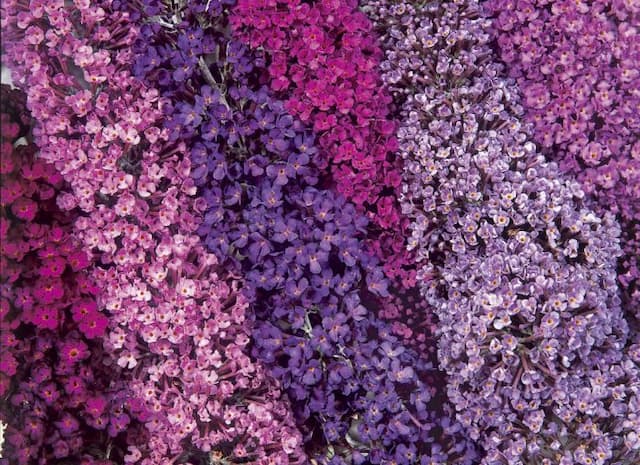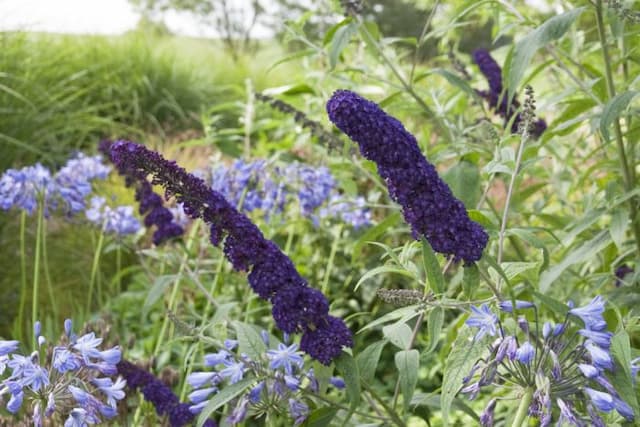Butterfly Bush Buddleja davidii Buzz Ivory = 'Tobudivory' (PBR) (Buzz Series)
![butterfly bush [Buzz Ivory]](/_next/image?url=https%3A%2F%2Fplants-admin.emdemapps.com%2Fimages%2Fplants%2F%2Fimages%2F604b57987dfa8.png&w=3840&q=75)
ABOUT
The plant known commonly as Butterfly Bush in the Buzz Ivory variety from the Buzz Series offers a visually appealing appearance with its distinctive features. This variety is characterized by panicles of sweetly scented flowers that are a creamy, ivory white color. These flowers are small, numerous, and densely packed together to form cone-shaped clusters that bloom profusely throughout the summer and into the fall, attracting a variety of pollinators, including butterflies and bees, lending to its common name. The foliage of the Butterfly Bush Buzz Ivory is equally attractive, with lance-shaped leaves that are a soft gray-green color, creating a pleasant contrast with the creamy white flowers. The leaves have slightly serrated edges and are arranged oppositely along the branches, which are numerous and create an arching habit. With its dense clusters of fragrant, ivory flowers and gray-green foliage, this variety of the Butterfly Bush adds a touch of elegance and a visually striking element to gardens. It is well-suited for mixed borders or as a stand-alone specimen, contributing a delightful aroma and a soft color palette to the landscape.
About this plant
 Names
NamesSynonyms
Butterfly Bush, Summer Lilac, Orange Eye.
Common names
Buddleja davidii 'Buzz Ivory', Buddleia davidii 'Buzz Ivory'.
 Toxicity
ToxicityTo humans
The Butterfly Bush, which is the common name for Buddleja davidii, including the Buzz Ivory variety, is not known to be highly toxic to humans. However, ingesting any part of the plant can potentially cause mild upset stomach or gastrointestinal discomfort in some individuals. It is always recommended to avoid eating ornamental plants and to keep them out of reach of young children who might ingest them out of curiosity.
To pets
For pets, the Butterfly Bush is also not considered to be highly toxic. However, it is always possible for pets to have a sensitivity to non-food plants, and ingesting parts of the plant could lead to gastrointestinal upset such as vomiting or diarrhea. As with humans, it is advisable to prevent pets from consuming ornamental plants to avoid potential health issues.
 Characteristics
CharacteristicsLife cycle
Perennials
Foliage type
Deciduous
Color of leaves
Green
Flower color
Ivory
Height
3 to 4 feet (0.9 to 1.2 meters)
Spread
3 to 4 feet (0.9 to 1.2 meters)
Plant type
Shrub
Hardiness zones
5
Native area
China
Benefits
 General Benefits
General Benefits- Attracts pollinators: Buddleja davidii, commonly known as Butterfly Bush, is highly attractive to butterflies, bees, and other beneficial insects, promoting biodiversity in the garden.
- Compact size: The 'Buzz' series are more compact than other varieties, making them suitable for smaller gardens or container planting.
- Long flowering period: This plant flowers from early summer to the first frosts, providing long-lasting color and interest.
- Low maintenance: Once established, the Butterfly Bush is drought tolerant and requires minimal care beyond occasional pruning.
- Fast growing: Buddleja davidii grows quickly, allowing gardeners to establish a flowering shrub in a relatively short period.
- Drought tolerance: The plant is well-adapted to dry conditions, making it a good choice for water-wise gardens.
- Deer resistance: The Butterfly Bush is generally resistant to deer, making it suitable for areas where deer browsing is a problem.
 Medical Properties
Medical Properties- This plant is not used for medical purposes.
 Air-purifying Qualities
Air-purifying QualitiesThis plant is not specifically known for air purifying qualities.
 Other Uses
Other Uses- Dye Production: The flowers of the Butterfly Bush can be used to create natural dyes for textiles, offering a range of colors from the lilac of the petals.
- Art Supplies: Dried flowers can be used to make eco-friendly confetti or for inclusion in homemade paper, adding texture and color to the finished product.
- Culinary Garnish: Edible flowers from the Butterfly Bush can be used to add a splash of color and a mild floral flavor to salads or desserts.
- Craft Projects: The branches of Butterfly Bush can be woven or used in basketry to create natural and rustic-looking home decor items.
- Photography Prop: Buddleja davidii makes a picturesque backdrop for photographers, especially for capturing butterflies and other pollinators.
- Insect Repellent: Certain compounds in Buddleja davidii leaves may have insect-repelling properties when crushed and applied to the skin.
- Educational Tool: Schools and educators can use the plant to teach students about the importance of pollinators in the ecosystem and the role of native and non-native plant species.
- Fragrance: The aromatic flowers can be used in homemade potpourris to impart a fresh, natural scent to a room.
- Bird Habitat: Butterfly Bush can provide shelter and nesting sites for small birds, enhancing local biodiversity in a garden setting.
- Soil Stabilization: Planted in masses, the Butterfly Bush can help minimize soil erosion on slopes due to its root system.
Interesting Facts
 Feng Shui
Feng ShuiThe Butterfly Bush is not used in Feng Shui practice.
 Zodiac Sign Compitability
Zodiac Sign CompitabilityThe Butterfly Bush is not used in astrology practice.
 Plant Symbolism
Plant Symbolism- Renewal: The Buddleja, also known as Butterfly Bush, is a plant that is often associated with renewal because it attracts butterflies, which symbolize transformation and new beginnings.
- Attraction: The sweet fragrance and vibrant flowers of the Butterfly Bush symbolize allure and the ability to draw in those around you, mirroring its attraction of wildlife.
- Hope: As the Butterfly Bush is a beacon for butterflies and other pollinators, it stands for hope and the promise that life continues and flourishes.
- Healing: In some cultures, the Butterfly Bush is thought to have medicinal properties, therefore symbolizing healing and restoration.
 Water
WaterThe Butterfly Bush requires moderate watering, especially during its growing season in spring and summer. It's best to water this plant when the top inch of the soil feels dry to the touch, which could be about once a week, depending on the climate and weather conditions. Provide the plant with 1 to 1.5 gallons of water each watering session, ensuring that the water penetrates deeply into the soil to encourage strong root development. During the winter months, reduce watering because the plant's water needs decrease in cooler temperatures and with less sunlight. Always ensure that the Butterfly Bush is planted in well-draining soil to prevent root rot from excessive moisture.
 Light
LightThe Butterfly Bush thrives in full sun, meaning it requires at least 6 hours of direct sunlight each day. It's important to place it in a position where it can get unfiltered sunshine throughout the day for optimal growth and flowering. If grown indoors, a south-facing window is the best spot, or if planting outside, choose an open area with minimal shade interference.
 Temperature
TemperatureThe Butterfly Bush prefers a temperate climate and can endure temperatures as low as 20 degrees Fahrenheit in winter, though it may die back to the ground in such cold. Ideal growing temperatures for the Butterfly Bush range from 60 to 90 degrees Fahrenheit. Ensure the plant is positioned where it can avoid the harsh winter conditions or provide winter protection if temperatures dip below the minimum threshold.
 Pruning
PruningPruning the Butterfly Bush is important to encourage new growth and more vigorous blooming. It should be pruned in late winter or early spring before new growth begins. Cut back the previous year's growth to 12 to 24 inches from the ground to promote a bushier plant with abundant flowers. Additionally, deadhead spent blooms periodically throughout the growing season to encourage more blooms and prevent self-seeding.
 Cleaning
CleaningAs needed
 Soil
SoilButterfly Bush thrives in well-drained soil enriched with compost or well-rotted manure. A balanced soil mix that holds moisture yet drains well is ideal. Aim for a soil pH between 6.0 and 7.0 for optimal growth.
 Repotting
RepottingButterfly Bush should be repotted every 2-3 years to replenish nutrients and expand root space. It's best to repot in the early spring before new growth begins.
 Humidity & Misting
Humidity & MistingButterfly Bush tolerates a wide range of humidity levels but prefers moderate conditions. It performs well in typical outdoor humidity levels without the need for special attention.
 Suitable locations
Suitable locationsIndoor
Ensure full sun, well-drained soil, and occasional pruning.
Outdoor
Plant in full sun, water deeply, and protect from strong winds.
Hardiness zone
5-9 USDA
 Life cycle
Life cycleBuddleja davidii Buzz Ivory, commonly known as Butterfly Bush, begins its life cycle when a seed, after dispersal and when conditions are right, germinates in well-drained soil, typically in early spring. The seedling then develops into a young plant, producing a rosette of leaves and, upon reaching maturity, a woody stem that enables it to grow into a shrub. Throughout the growing season, the Butterfly Bush enters a vegetative stage characterized by the growth of leaves and branches, followed by a flowering stage in late summer where it produces abundant ivory-colored, fragrant blooms that attract butterflies and other pollinators. After pollination, the plant sets seed, which will be dispersed by wind or animals, thereby completing the reproductive cycle. With the approach of autumn and cooler temperatures, the Butterfly Bush enters a period of dormancy, shedding leaves and ceasing active growth above ground while the roots remain viable. The plant will remain dormant through winter, resuming growth and repeating this cycle when temperatures rise in the spring, assuming it is a perennial in the given climate.
 Propogation
PropogationPropogation time
Spring-Summer
Propogation: The Butterfly Bush 'Buzz Ivory' is commonly propagated through semi-hardwood cuttings. This is typically done in late summer. During this period, a gardener would select a healthy, non-flowering stem and cut a length of about 4-6 inches (10-15 cm), just below a leaf node. The lower leaves are then stripped off and the cut end may be dipped in rooting hormone to encourage root growth, though this is not always necessary. The cutting is then planted in a moist, well-draining potting mix and placed in a warm, bright spot out of direct sunlight, with a plastic bag or cover to retain humidity. Roots generally develop within a few weeks, after which the new plant can gradually be acclimatized to normal conditions and eventually planted out.


![Butterfly bush [Adonis Blue]](/_next/image?url=https%3A%2F%2Fplants-admin.emdemapps.com%2Fimages%2Fplants%2F%2Fimages%2F604b56e58f983.png&w=640&q=75)


![Butterfly bush [Camberwell Beauty]](/_next/image?url=https%3A%2F%2Fplants-admin.emdemapps.com%2Fimages%2Fplants%2F%2Fimages%2F604b5ead04c12.png&w=640&q=75)



